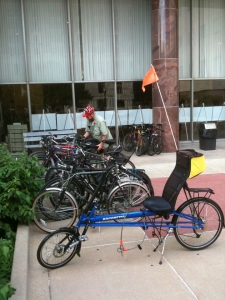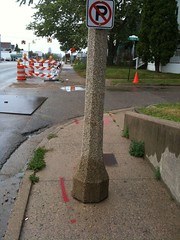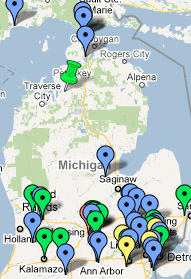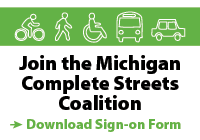You are currently browsing the monthly archive for August 2009.

The bike rack was overflowing in front of City Hall as over 60 Complete Streets supporters came out to testify before City Council on August 10, 2009.
The Lansing City Council voted unanimously on Monday night to adopt a Complete Streets and Non-Motorized Plan Ordinance. This is a big victory for cyclists and pedestrians in Lansing, and for the Complete Streets movement in Michigan. Lansing becomes the first municipality in the State of Michigan to pass a Complete Streets ordinance, and joins a host of other communities across the state in committing to develop a non-motorized plan.
The effort to pass the ordinance was organized by the Walk and Bike Lansing! Task Force. Led by the Mid-Michigan Environmental Action Council, the task force is composed of a diverse group of community and state partners, including LMB and MEC. The initiative came to City Council by way of a signature drive, through which volunteers collected over 4,520 signatures of registered Lansing voters. Another 90 letters of support and 60 public comments at a recent Council meeting didn’t hurt, either.
There’s more information on this milestone at the Walk and Bike Lansing! website, but in summary, this ordinance:
- Requires the City of Lansing to adopt a Non- Motorized Network Plan.
- The Non-Motorized Network Plan would include, at a minimum, accommodations for accessibility, sidewalks, curb ramps and cuts, trails and pathways, signage, and bike lanes, and shall incorporate the principles of Complete Streets and maximize walkable and bikeable streets within the City.
- To the extent financially feasible, future construction or reconstruction of City rights-of- way or any parts thereof shall be in conformity with the Non-Motorized Network Plan.
- Sets a goal to adequately funding walk- and bike-friendly infrastructure. (The City of Lansing currently spends 2% to 3% for non-motorized facilities. The ordinance sets a goal of 5% for future budget years).
- Require an update of the Non-Motorized Network Plan every five years from the date of adoption.
Congratulations, Lansing! Here’s to hoping other Michigan communities and road agencies follow your lead!
By Barbara McCann - National Complete Streets Coalition
 The Centers for Disease Control and Prevention (CDC) is recommending that communities adopt complete streets policies in their fight against obesity – and has recommended using our Coalition’s standards to measure their success. The development is one in a new flurry of study results, meetings, and reports from the public health community are pointing the way toward complete streets policies as an important tool in the fight against the obesity crisis.
The Centers for Disease Control and Prevention (CDC) is recommending that communities adopt complete streets policies in their fight against obesity – and has recommended using our Coalition’s standards to measure their success. The development is one in a new flurry of study results, meetings, and reports from the public health community are pointing the way toward complete streets policies as an important tool in the fight against the obesity crisis.
This week the CDC pushed beyond its traditional comfort zone to recommend policy strategies for obesity prevention, and outlined them in a report in the influential Morbidity and Mortality weekly report (MMWR). Six of the 24 recommendations relate directly to complete streets and smart growth, with one making specific reference to complete streets: enhance traffic safety in areas where people are or could be physically active. The suggested measure for communities to use is as follows:
Local government has a policy for designing and operating streets with safe access for all users which includes at least one element suggested by the National Complete Streets Coalition (www.completestreets.org).
This measurement assesses whether a community has a policy for all-user street design, such as the Complete Streets program. Specific elements of the measurement are based on Complete Streets policy.
The other recommendations include:
- Enhance infrastructure supporting walking.
- Enhance infrastructure supporting bicycling.
- Improve access to public transportation.
- Zone for mixed-use development.
- Support locating schools within easy walking distance of residential areas.
And another represents the way many communities are pursuing complete streets:
- Participate in community coalitions or partnerships to address obesity.
Read the rest of this entry »
As reported on WSJM.com:
http://www.wsjm.com/Meeting-Welcomes-Public-To-Talk-Freight-Planning/4985082
The Southwest Michigan Planning Commission is inviting the public to its Monday [August 17, 2009] meeting next week to get public input for the Twin Cities Area Transportation Study. Associate Transportation Planner Anna Rahtz says the commission is trying to extend public out reach to get more community attendance.
The meeting will include a special presentation on freight planning. And Rahtz says other topics include the Statewide Complete Streets legislation for safe, walkable streets and the possibility of a high speed rail in Southwest Michigan. The meeting is at the Southwest Michigan Regional Airport, Monday at 9:30 a.m.
Low-fi recording of CH6 news coverage of Complete Streets public hearing at Lansing City Council on Monday, August 10, 2009. More than 60 people came out in support of the ordinance.
Vodpod videos no longer available.
Links to additional recent news coverage of the Lansing Complete Streets movement:
http://tinyurl.com/peo6pv - LSJ, 8/11/09
http://tinyurl.com/r7awhw - WKAR 8/11/009
http://tinyurl.com/pevggn - WKAR, 8/10/09
http://bit.ly/CrTWM - LSJ, 8/10/09
http://bit.ly/k2LQe - LSJ, 8/6/09
http://bit.ly/27A8QH - City Pulse, 8/5/09
http://tinyurl.com/qyhtxk - WKAR, 7/10/09
http://tinyurl.com/mqo5b5 - WILX, 6/26/09
Michigan Department of Transportation, in collaboration with Michigan Department of Community Health, and Michigan Housing Development Authority, is pleased to offer several opportunities for you to attend an AASHTO Bicycle Facility Design Training.
This is a training course on the planning and design of on-road bicycle facilities. There will be a two hour class instruction on the AASHTO Guide for the Development of Bicycle Facilities, an on-road bicycle ride to analyze the different types of on-road facilities, and a discussion period regarding bicycle facility design options. There will be many stops during the ride to point out potential facility types.
Training Wheels Registration Form
Course size is limited.
September 8, 2009 -Traverse City, MI 9:30 a.m. to 2:00 p.m.
September 9, 2009 - Grayling, MI 9:00 a.m. to 2:00 p.m.
September 10, 2009 - Ludington, MI 9:00 a.m. to 2:00 p.m.
September 11, 2009 - Grand Rapids, MI 9:00 a.m. to 2:00 p.m.
September 17, 2009 - Flint, MI 9:00 a.m. to 2:00 p.m.
September 16, 2009 - Mt. Pleasant, MI 9:00 a.m. to 2:00 p.m.
September 15, 2009 - Jackson, MI 9:00 a.m. to 2:00 p.m.
September 14, 2009 - Lansing, MI 9:00 a.m. to 2:00 p.m.
September 18, 2009 - Detroit, MI 9:00 a.m. to 2:00 p.m.

 The Michigan Complete Streets Coalition recently launched a statewide collaborative photo project to document the current conditions of Michigan roads focusing on “complete” and “incomplete” streets.
The Michigan Complete Streets Coalition recently launched a statewide collaborative photo project to document the current conditions of Michigan roads focusing on “complete” and “incomplete” streets.
While the photo project is a statewide effort (currently we have images from Grand Rapids, Flint, Traverse City and Detroit), a pilot website has been launched that specifically highlights Lansing. The goal is to help document the good, bad and ugly of Lansing roadways in order to motivate City Council to adopt a Complete Streets ordinance.
You can visit the new site at:
www.LMB.org/LansingCompleteStreets.html
Recently over 4,500 Lansing registered voters signed a Complete Streets petition, making it the first citizen-driven ballot initiative in the City since 1990. The petition will be presented to City Council on August 10th, 2009 where they will have the opportunity to either adopt the ordinance or put it on the November ballot where citizens can directly vote on it.
The new website is powered using Flickr.com, a popular photo sharing site and uses Tags, or keywords, to pull up images in different categories such as “Bike Lanes,” “Bus Shelters,” “Curb Cuts,” etc. While we are still working on refining the categories and adding descriptions and titles to all the images, we are pleased to announce the Beta version of the site.
We are actively seeking people to document more of Lansing roads, as well as other communities across Michigan. If you are interested in helping to take photos, or if you have comments or suggestions, please contact John Lindenmayer at the League of Michigan Bicyclists.















